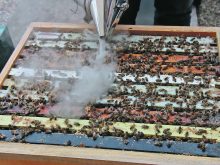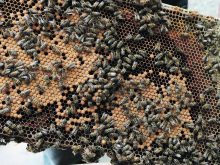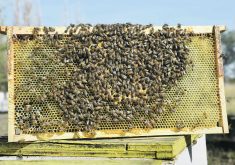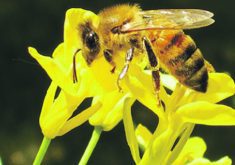Not long ago, queen bees lasted two to three years before a beekeeper had to replace them.
But they’re not living that long any more and beekeepers are asking why.
“I don’t know if you get a year and a half any more…. So. What’s going on? Why are the queens not lasting?” asked Bryan Ash, a beekeeper from Gilbert Plains, Man.
Scientists with the U.S. Department of Agriculture may have found an answer.
In a study published this month in Plos One, entomologists learned that queen bees can be exposed to extreme temperatures when shipped by mail or courier. The severe temperatures, even for short periods, may compromise the queen’s ability to reproduce.
Read Also

First annual Ag in Motion Junior Cattle Show kicks off with a bang
Ag in Motion 2025 had its first annual junior cattle show on July 15. The show hosted more than 20…
“As many as 20 percent of the (queen) shipments experienced temperature spikes that approached extremes of 105.8° F (41.1 C) and 46.4° F (8 C) for more than two hours at a time,” the USDA said in a release.
“Those exposed to extreme high or low temperatures during shipping had sperm viability reduced by 50 percent.”
The USDA said commercial beekeepers usually order replacement queens already mated, because queens only mate during the first few weeks of life. Queens use the stored semen to fertilize eggs laid throughout their lives. A queen bee fails when it dies or doesn’t produce enough viable eggs to maintain the colony.
USDA laboratory testing confirmed that severe temperatures damage the sperm stored inside a queen. Inseminated queens exposed to 40 C for one to two hours, or to 5 C for one to four hours, had sperm viability decline to 20 percent from 90.
Canadian beekeepers often import queens from California, New Zealand, Australia and Hawaii. Severe temperature variations are possible over those distances.
“The good news is with fairly simple improvements in packaging and shipping conditions, we could have a significant impact on improving queens and, in turn, improving colony survival,” said Jeff Pettis, leader of the USDA bee research lab in Beltsville, Maryland.
Queen failures have reached unprecedented levels in the U.S. They used to live one to two years but are now failing after six months.
“This high rate of queen failure coincides with the high mortality rates of colonies in the U.S., some years with (more than) 50 percent of colonies dying,” the USDA said.
The shorter life expectancy for queens may be causing higher rates of colony loss in the summer. Ash said Manitoba beekeepers used to lose two to three percent of their hives over the summer. Now, a 10 to 12 loss percent isn’t unusual.
“You lose about three percent of your queens (per month),” he said.
Besides temperature extremes, USDA scientists also determined that diseases are contributing to queen bee failures.
Queens in the study had a high rate deformed wing virus and many of the queens were infected with other pathogens, such as nosema ceranae.
Contact robert.arnason@producer.com


















